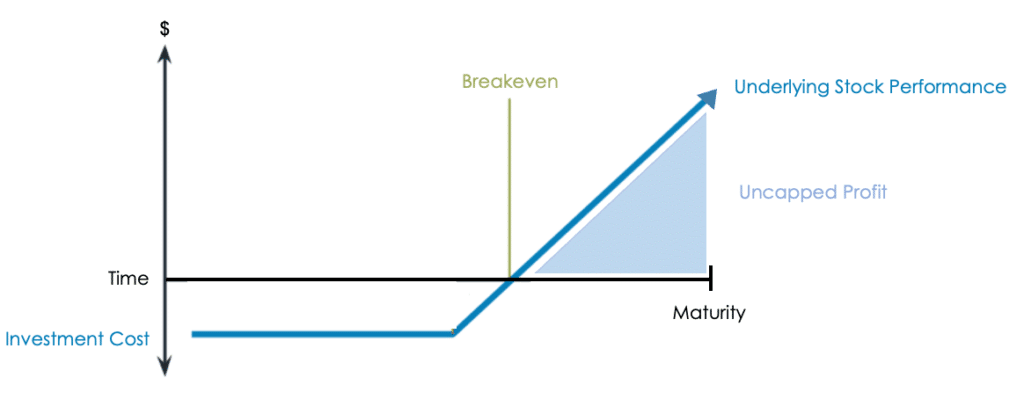In this educational series, we aim to to help advisers and investors better understand how various structured investments are assembled, what the potential returns look like, and the risks associated with the type of structured investment in focus.
We hope that this educational series will help dispel some of the myths around structured investments, and encourage investors to speak with their advisors to help them identify structured investments that are suitable for their risk profile, and portfolio objectives.
Education Series Part 2
There are many ways to structure leveraged investments, but in this article, we look at one of the more basic Leveraged Structured Investments, and we will cover some of the more exotic structures in a future post.
In this post, we will explain some of the basic concepts of leverage, and draw comparisons to using leverage to buy property. By the end of this post, you should have a better understanding regarding the pros and cons associated with leveraged structured investments.
Leveraged Structured Investments are generally for investors seeking amplified returns, and offer a unique combination of market exposure, leverage and a pre-defined level of risk, and some investors using leverage may be entitled to certain taxation benefits. Before breaking down Leveraged Structured Investments, lets look at other methods investors can use to gain leverage in the stock market.
How can I gain leverage over the stock market?
Investors can obtain leverage over the stock market in many ways; buying Exchange Traded Options (“ETO“) provides an efficient, cost effective manner to gain leverage over a single stock or ETF, and while the performance of the underlying security impacts the price of an ETO, it is not directly correlated with the performance of the underlying security.
An ETO’s price is dictated by many factors, making it difficult to accurately forecast what the potential return may be, and there are complicated formula’s that can be used to predict the future value of an ETO, but its not an exact science, and market factors can skew returns.

Another common method to gain leverage over the stock market is via a Margin Loan. These products operate in a similar manner to other types of investment loans, like investment property loans, and feature an LVR (Loan to Value Ratio), which if breached because of a fall in the stock market, can result in a margin call. A margin call means that the lender requires the borrower to deposit cash into their account to bring the LVR back to an acceptable level.
Limited Recourse Borrowing
Anadara offers leverage via a limited recourse loan, and the principle is very similar to the way most Australian’s buy property; borrow money from the bank, and then make regular interest payments until the loan and interest is completely paid off. When buying a property using a loan, the buyers do so assuming the value of the property will increase.
The risk is, that if the value of the property falls, and the owner is forced to sell for any reason, there could be a deficit remaining on the loan balance that will be required to be repaid. This cannot happen with a limited recourse loan, and Anadara’s limited recourse loans include the following key features:
- Prepaid Interest – the interest for the term of the loan is paid in advanced, and upfront;
- Limited Recourse – if the value of the underlying security falls over the investment term, the lender is unable to pursue the investor for any deficit.
This means that the maximum risk associated with any of the Leveraged Structured Investments offered by Anadara is limited to the amount of interest paid upfront, plus any loan application fee or advisor fee (together, referred to as the ‘Investment Cost“). The leveraged structured investments offered by Anadara consist of two key components:
- Limited Recourse Loan Component – Anadara lends the investor 100% of the amount they wish to invest. The investor is required to pay the Investment Cost upfront.
- Underlying Asset Component – each Leveraged Structured Investment uses the proceeds of the Limited Recourse Loan is used to obtain 100% exposure to an underlying asset. The underlying asset can be a single stock, basket of stocks, ETF, currency or commodity.
When investing in one of Anadara’s Leveraged Structured Investments, the breakeven point is where the performance of the underlying asset over the investment term is greater that the Investment Cost.

How do Leveraged Structured Investments work?
When an investor invests in one of Anadara’s Leveraged Structured Investments, if the underlying asset performs positively over the investment term, the leverage magnifies any gains, but in the case of negative performance, the investor may lose the entire Investment Cost, which is the maximum amount at risk, regardless of how poorly the underlying asset performs.
Below, we will create a hypothetical example to demonstrate how the use of leverage can impact returns.
Leveraged Structured Investment Example
For this theoretical example, we will create a bullish leveraged structured investment with the BetaShares Crude Oil ETF as the underlying asset. Please note, that the below example is for illustrative purposes only:
- Investment Amount: $100,000
- Loan Amount: $100,000
- Loan Interest Rate: 6% per annum
- Investment Term: 12 Months
- Underlying Asset: BetaShares Crude Oil ETF (ASX.OOO)
In this example, the investor is bullish on oil, and asks Anadara to create a leveraged investment with exposure to crude oil. Based on the hypothetical terms outlined above, the investor is borrowing $100,000 and paying upfront interest of $6,000 (6%). Lets look at the steps Anadara takes to create this leveraged structured investment:

Potential Outcomes
These outcomes are hypothetical only to demonstrate the potential returns the investor would receive at maturity based on the terms outlined above and the hypothetical performance of the BetaShares Crude Oil ETF over the investment term.
Outcome 1: Crude Oil Price Growth
If the BetaShares Crude Oil ETF (“OOO“) increases by 10% over the 12 month Investment Term, the investors return would be calculated as follows:
- Underlying Performance: 10% x Investment Amount of $100,000 = $10,000
- Total Return: Underlying return of $10,000 / Prepaid Interest of $6,000 ($10,000 / $6,000) = 66%

Outcome 2: Crude Oil Price Declines
If the BetaShares Crude Oil ETF (“OOO“) decreases by 10% over the 12 month Investment Term, the investors return would be calculated as follows:
- Underlying Performance: -10% x Investment Amount of $100,000 = -$10,000
- Total Return: Underlying return of -$10,000 / Prepaid Interest of $6,000 (-$10,000 / $6,000) = -66%
In this example, the losses associated with the investment are greater than the Investment cost. But as the investment loan is limited recourse, the investor is not liable to pay anything further. So in this case, the return on the Investment Cost is a loss of 100%. The chart below shows the investment flow of funds for this outcome:

These outcomes show how leverage can magnify gains and losses. Leveraged investments like this one, are only suitable for investors that have a strong view that the underlying asset will increase substantially and outperform the broader market over the investment term.
Tax Effective Investment
As with loans for investment properties in Australia, the interest component may be tax deductible. This is also the case for structured investments issued by Anadara via the use of a limited recourse loan. Anadara has been issued with Australian Taxation Office Product Ruling 2024/6, which confirms the tax treatment of the upfront interest for eligible investors that invest in one of Anadara’s Leveraged Structured Investments.

This means that if you’re an eligible investor, the interest that is required to be paid upfront may be tax deductible. For more information, ATO Product Ruling 2024/6 can be viewed on the ATO Website HERE.
Leveraged Structured Investment Benefits and Risks
The benefits of leveraged structured investments are clear, gains are enhanced if the underlying asset performs positively, and the tax effective possibilities can also be a benefit for eligible investors. Leverage via a limited recourse loan also offers two key advantages over margin loans and a traditional investment loan:
- No Margin Calls – There are no margin calls with a limited recouse loan. Regardless of how poorly the underlying asset performs, the investor will not be required to make additonal payments.
- Limited Losses – With limited recourse loans, losses are limited to the amount of prepaid intererst, plus any fees. This means that even if the underlying asset falls in value by over 50%, the investor is not liable to pay for those losses.
As with all investments, there are risks associated with Leveraged Structured Investments, including the risk of losing 100% of the Investment Cost.
Other significant risks include a lack of liquidity, as it can be difficult, or expensive, to exit one of these investments before the maturity date, and counterparty risk is also a key risk. Anadara works with a panel of global tier one investment banks to help create these products, and you’re welcome to ask Anadara about the credit rating of the hedge counterparty before investing in one of these products.
Please note that this is not an exhaustive list of the risks associated with Leveraged Structured Investments, and you should review the Master IM and Term Sheet IM of each product with your professional adviser before making any decision to invest.
Summary
Leveraged Structured Investments can be a valuable investment tool for those investors with a high tolerance for risk, that are seeking outperformance from a small part of their investment portfolio. There is also the option to create bearish versions of these products, where profits may be realised when the underlying asset falls in value over the Investment Term.
In this post, we have looked at the most basic Leveraged Structured Investment, but there are other types of leveraged products offered by Anadara, such as Leveraged Shark Fin Notes, which increase the amount of leverage at the expense of unlimited profit potential..
There is also Anadara’s Leveraged Dividend Harvester products, which provide leveraged exposure to large cap stocks while also paying dividends to investors over the investment term. We will feature each of these products, and others, in future posts.
If you’d like to chat about structuring an investment linked to almost any tradable security from any of the major global exchanges, please get in touch with us to help you create a customised product for you.
As with any financial product, understanding the structure and potential payoff scenarios is key to making an informed decision. We highly recommend that investors speak to their professional adviser before choosing to invest in any of our products.
If you would like to subscribe to Anadara’s educational series and learn more about structured investments, please enter your details below.



